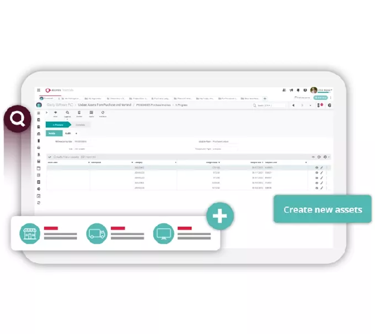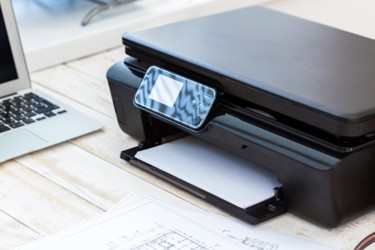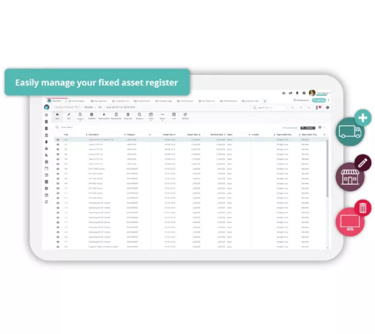Fixed Asset Management Software
Our leading fixed asset management software is designed to help you integrate your fixed asset register and accounting for effective asset management and accurate financial reporting.
Access Financials asset management software provides a single set of data that helps you simplify, automate and more effectively manage and report on all your fixed assets.

Integrated fixed asset management and accounting software
Easily manage your fixed asset register
Access Financials Fixed Assets module makes managing a large number of assets, or those that have non-standard depreciation easy. Manage your assets every step of the way - from purchase to disposal.
- Import asset details: easily import new assets straight from purchase invoices or Access Financials purchase ledger. Automated asset numbering and barcoding assist with the control of large volumes.
- Record all asset information: the equipment database in the asset manager acts as an additional information source, eliminating the need for different databases. Record a wide range of data, including purchase information, supplier, location, serial number, images, documents, insurance policies, service
dates, owner, depreciation categories and linked assets. - Asset tracking: easily trace asset locations, values, disposals, revaluations, profit on disposals, asset component listings and more. Sort, group, subtotal, filter, and drill down to generate custom reports.

Manage assets throughout their lifecycle
Asset manager helps you account for your fixed assets throughout their lifecycles.
- Quick summaries: view the current value of assets and get an 'at-a-glance' version from previous years.
- Depreciation management: set default depreciation, including using a straight line, sum of digits or reducing balance methods. Allows assets to be depreciated - with or without a residual value - and disposed of or added to, at any time.
- Lifecycle management: Run depreciation, revaluations, additions, disposal and duplication on individual assets, selected assets or in bulk.
- Asset history: records all depreciation, disposal and revaluations to give you a full audit trail for the lifecycle of the asset.

Automate your fixed asset management
Access Financials asset management software is designed to help you manage large numbers of assets or those with non-standard depreciation. Fully integrated with the core accounting module, it makes recording, managing and auditing your asset register easy and efficient.
Automatic valuations and general ledger updates simplify fixed asset accounting, providing all the data you need and saving you time and eliminating the potential for error. Let automated fixed asset management take the burden out of managing your fixed asset register.

How fixed asset management software can benefit your business
Access Financials fixed asset accounting software is available through Access Workspace, so you'll also
benefit from:
- Everything in one place: all your Access software, data and processes joined up and in one place for greater productivity.
- Easy-to-use apps: empower your people to self-serve and access real-time reporting – removing endless requests and bottlenecks.
- Advanced analytics: combine your financial data, with your other Access products and third-party data sources into a single, up-to-date view to help your people make the best decisions.
- Industry-leading cloud hosting: 100% uptime performance, enterprise-level security, automatic software upgrades and backups.

Keep up to date with the latest in Accounting and Finance
Visit our Finance Resources Hub or our Finance Blog for the latest research, guides and insights from our team of experts.

Explore our financial management solutions
Explore the various features and benefits of the Access Financial Management ecosystem.
Fixed Asset Accounting FAQs
What is fixed asset accounting software?
Fixed asset management software enables organisations to track their fixed assets, locations, owner, maintenance schedule, cost and other information in an asset register. It automatically calculates the depreciation of each asset.
Asset management software features reporting facilities such as pre-built reports, category-wise, and department-wise assets reports, check-in/check-out, the balance sheet value of assets, assets payable, audit history, and transactions. Information is all kept within one database, helping reduce admin, manage maintenance, improve purchasing decisions and accurately calculate depreciation.
Read our full article on What is fixed asset accounting? which also covers the fixed asset accounting cycle and how to simplify your fixed asset accounting.
What is a fixed asset register?
In simple terms, a fixed asset register is a formal record of all the assets (or physical entities) owned by the company as well as their value. Many businesses also include other useful information such as the location of the asset, individual details such as ID numbers, who in the company is responsible for the asset, and other finance details such as the internal cost centre it is logged against and any depreciation numbers.
View our full article on the definition of a fixed asset register including examples of fixed assets in accounting, the purpose of a fixed asset register, what to include and much more.
What is fixed asset accounting software?
Fixed asset management software enables organisations to track their fixed assets, locations, owner, maintenance schedule, cost and other information in an asset register. It automatically calculates the depreciation of each asset.
Asset accounting software features reporting facilities such as pre-built reports, category-wise, and department-wise assets reports, check-in/check-out, the balance sheet value of assets, assets payable, audit history, and transactions. Information is all kept within one database, helping reduce admin, manage maintenance, improve purchasing decisions and accurately calculate depreciation.

 UK
UK
 SG
SG
 MY
MY
 US
US
 IE
IE